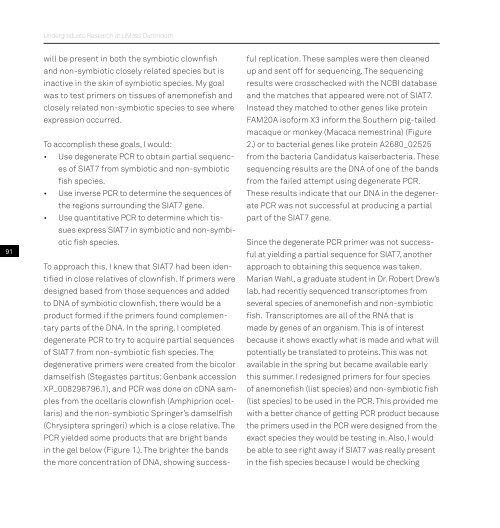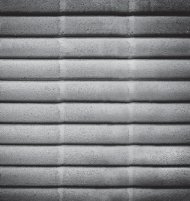Undergrad_Book_16-18_Pge_View_Print_no print marks_compressed
You also want an ePaper? Increase the reach of your titles
YUMPU automatically turns print PDFs into web optimized ePapers that Google loves.
<strong>Undergrad</strong>uate Research at UMass Dartmouth<br />
91<br />
will be present in both the symbiotic clownfish<br />
and <strong>no</strong>n-symbiotic closely related species but is<br />
inactive in the skin of symbiotic species. My goal<br />
was to test primers on tissues of anemonefish and<br />
closely related <strong>no</strong>n-symbiotic species to see where<br />
expression occurred.<br />
To accomplish these goals, I would:<br />
• Use degenerate PCR to obtain partial sequences<br />
of SIAT7 from symbiotic and <strong>no</strong>n-symbiotic<br />
fish species.<br />
• Use inverse PCR to determine the sequences of<br />
the regions surrounding the SIAT7 gene.<br />
• Use quantitative PCR to determine which tissues<br />
express SIAT7 in symbiotic and <strong>no</strong>n-symbiotic<br />
fish species.<br />
To approach this, I knew that SIAT7 had been identified<br />
in close relatives of clownfish. If primers were<br />
designed based from those sequences and added<br />
to DNA of symbiotic clownfish, there would be a<br />
product formed if the primers found complementary<br />
parts of the DNA. In the spring, I completed<br />
degenerate PCR to try to acquire partial sequences<br />
of SIAT7 from <strong>no</strong>n-symbiotic fish species. The<br />
degenerative primers were created from the bicolor<br />
damselfish (Stegastes partitus; Genbank accession<br />
XP_008298796.1), and PCR was done on cDNA samples<br />
from the ocellaris clownfish (Amphiprion ocellaris)<br />
and the <strong>no</strong>n-symbiotic Springer’s damselfish<br />
(Chrysiptera springeri) which is a close relative. The<br />
PCR yielded some products that are bright bands<br />
in the gel below (Figure 1.). The brighter the bands<br />
the more concentration of DNA, showing successful<br />
replication. These samples were then cleaned<br />
up and sent off for sequencing. The sequencing<br />
results were crosschecked with the NCBI database<br />
and the matches that appeared were <strong>no</strong>t of SIAT7.<br />
Instead they matched to other genes like protein<br />
FAM20A isoform X3 inform the Southern pig-tailed<br />
macaque or monkey (Macaca nemestrina) (Figure<br />
2.) or to bacterial genes like protein A2680_02525<br />
from the bacteria Candidatus kaiserbacteria. These<br />
sequencing results are the DNA of one of the bands<br />
from the failed attempt using degenerate PCR.<br />
These results indicate that our DNA in the degenerate<br />
PCR was <strong>no</strong>t successful at producing a partial<br />
part of the SIAT7 gene.<br />
Since the degenerate PCR primer was <strong>no</strong>t successful<br />
at yielding a partial sequence for SIAT7, a<strong>no</strong>ther<br />
approach to obtaining this sequence was taken.<br />
Marian Wahl, a graduate student in Dr. Robert Drew’s<br />
lab, had recently sequenced transcriptomes from<br />
several species of anemonefish and <strong>no</strong>n-symbiotic<br />
fish. Transcriptomes are all of the RNA that is<br />
made by genes of an organism. This is of interest<br />
because it shows exactly what is made and what will<br />
potentially be translated to proteins. This was <strong>no</strong>t<br />
available in the spring but became available early<br />
this summer. I redesigned primers for four species<br />
of anemonefish (list species) and <strong>no</strong>n-symbiotic fish<br />
(list species) to be used in the PCR. This provided me<br />
with a better chance of getting PCR product because<br />
the primers used in the PCR were designed from the<br />
exact species they would be testing in. Also, I would<br />
be able to see right away if SIAT7 was really present<br />
in the fish species because I would be checking



